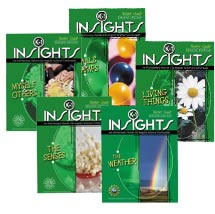Insights: An Inquiry-Based Elementary School Science Curriculum (Kindergarten and First Grade Modules)
By Karen Worth and the Insights Elementary Project Staff
 Insights is an innovative, inquiry-based, hands-on science curriculum for elementary school students. The full curriculum consists of 21 modules that represent a balance of life, earth, and physical science. The modules also highlight six major science themes: systems, change, structure and function, diversity, cause and effect, and energy. Each module is made up of a carefully sequenced, age-appropriate set of hands-on experiences designed to be directly relevant to the child. The modules are designed for use in self-contained elementary classrooms, and can be used as a core curriculum to be expanded as necessary, or individually in conjunction with existing programs.
Insights is an innovative, inquiry-based, hands-on science curriculum for elementary school students. The full curriculum consists of 21 modules that represent a balance of life, earth, and physical science. The modules also highlight six major science themes: systems, change, structure and function, diversity, cause and effect, and energy. Each module is made up of a carefully sequenced, age-appropriate set of hands-on experiences designed to be directly relevant to the child. The modules are designed for use in self-contained elementary classrooms, and can be used as a core curriculum to be expanded as necessary, or individually in conjunction with existing programs.
Contact Info: Karen Worth (1-800-225-4276 x2428)
Project Website: Insights: An Elementary Hands-on Inquiry Science Curriculum
Published by: Kendall/Hunt Publishing Order Info
The Weather: This module, designed to be used for a season or throughout the year, begins with a trip outside to observe and describe the weather. Students then focus their attention on four elements of weather: cloud cover, temperature, wind, and rain. Using their senses and simple tools, they describe, measure, and record data about each element and consider the impact of each on the environment. Students also use their data to make charts and look for patterns across days, weeks, and even seasons.
Price: Grades K–1
(2nd Ed.)
Myself & Others: Children look at themselves and their classmates, and explore similarities and differences in such characteristics as height, eye color, and hand size. They become aware of how they are similar to those children they may see as different because of a physical characteristic (such as skin color) and how they are different from those children they may otherwise see as similar. This module helps to create a positive, supportive atmosphere in which children can realize and appreciate that although each of them is unique, they all share many similar characteristics.
Price: Grades K–1
(2nd Ed.)
The Senses: Children are provided with a variety of experiences that encourage them to use all their senses to more closely observe and describe objects and phenomena around them. They compare, sort, and classify objects by various properties. They compare their senses one to the other, raising questions of what it would be like to be unable to hear or see.
Price: Grades K–1
(2nd Ed.)
Balls & Ramps: This module builds on children's prior experiences with balls and how they move. Children focus on two themes: the properties and characteristics of balls and some of the factors that affect the way balls behave. Children begin by comparing how a wide variety of balls roll and bounce; next make their own balls out of clay and many other materials; and then explore the movement of different balls as the balls roll down ramps, through tubes, and around bends.
Price: Grades K–1
(2nd Ed.)
Living Things: This module builds on the natural curiosity and excitement young children have for the natural world around them. Throughout the module, they observe the changes in a tree; examine the plants and animals living in and around the tree; and look at other living things nearby. Children think about and discuss the many needs of plants and animals and the dependence living things have on one another. Using these experiences, children build terraria in the classroom.
Price: Grades K–1
(2nd Ed.)
